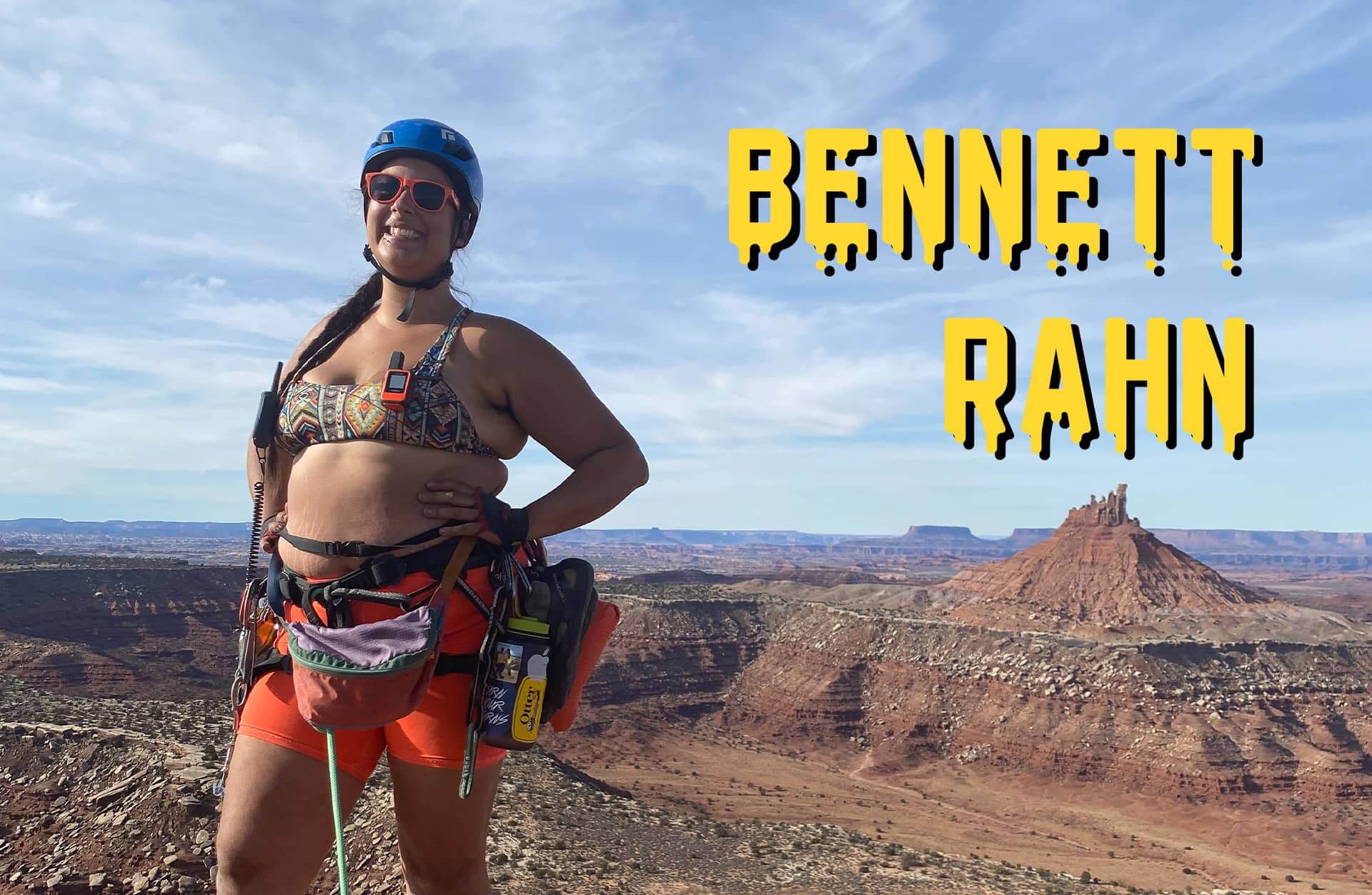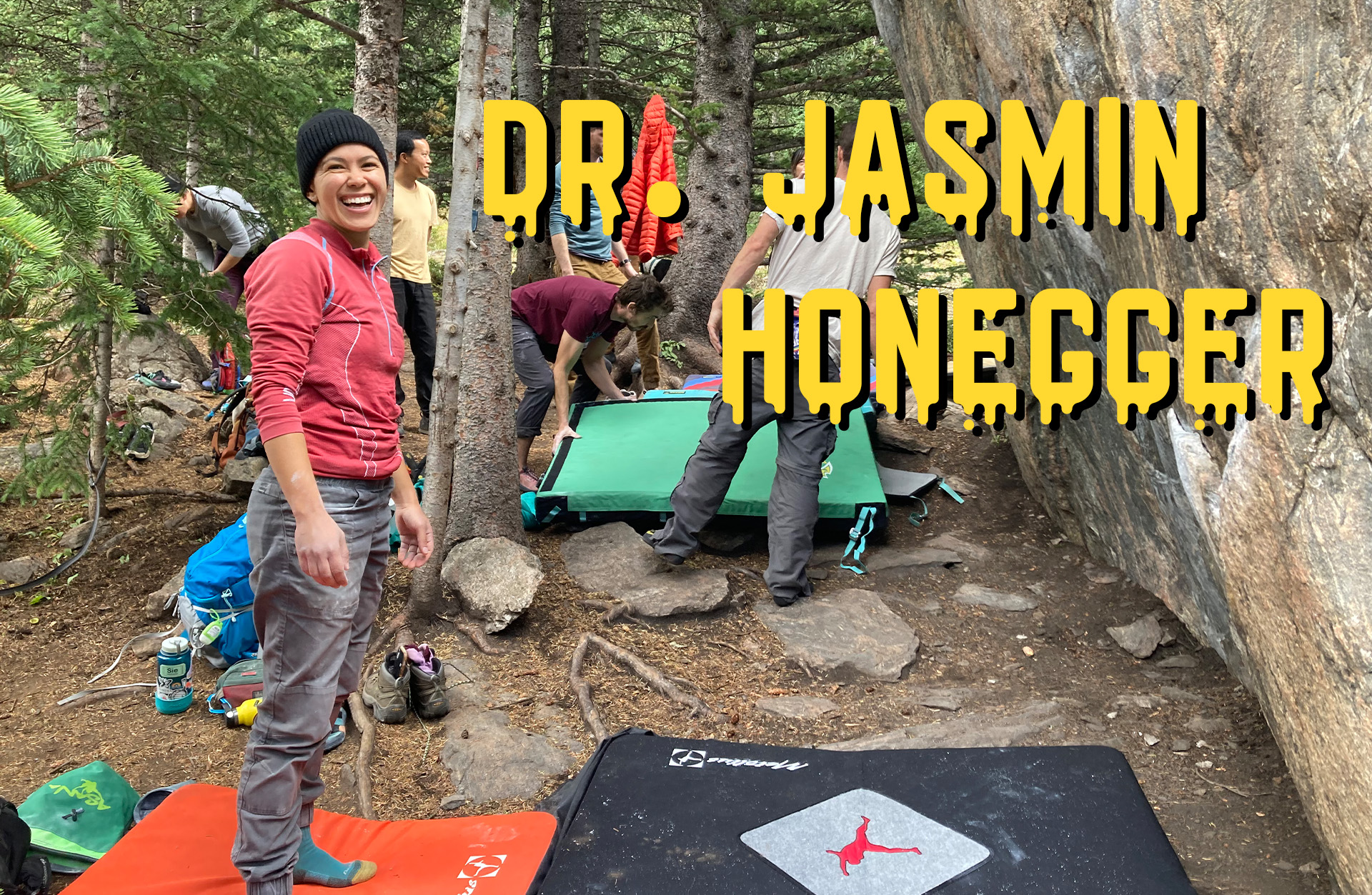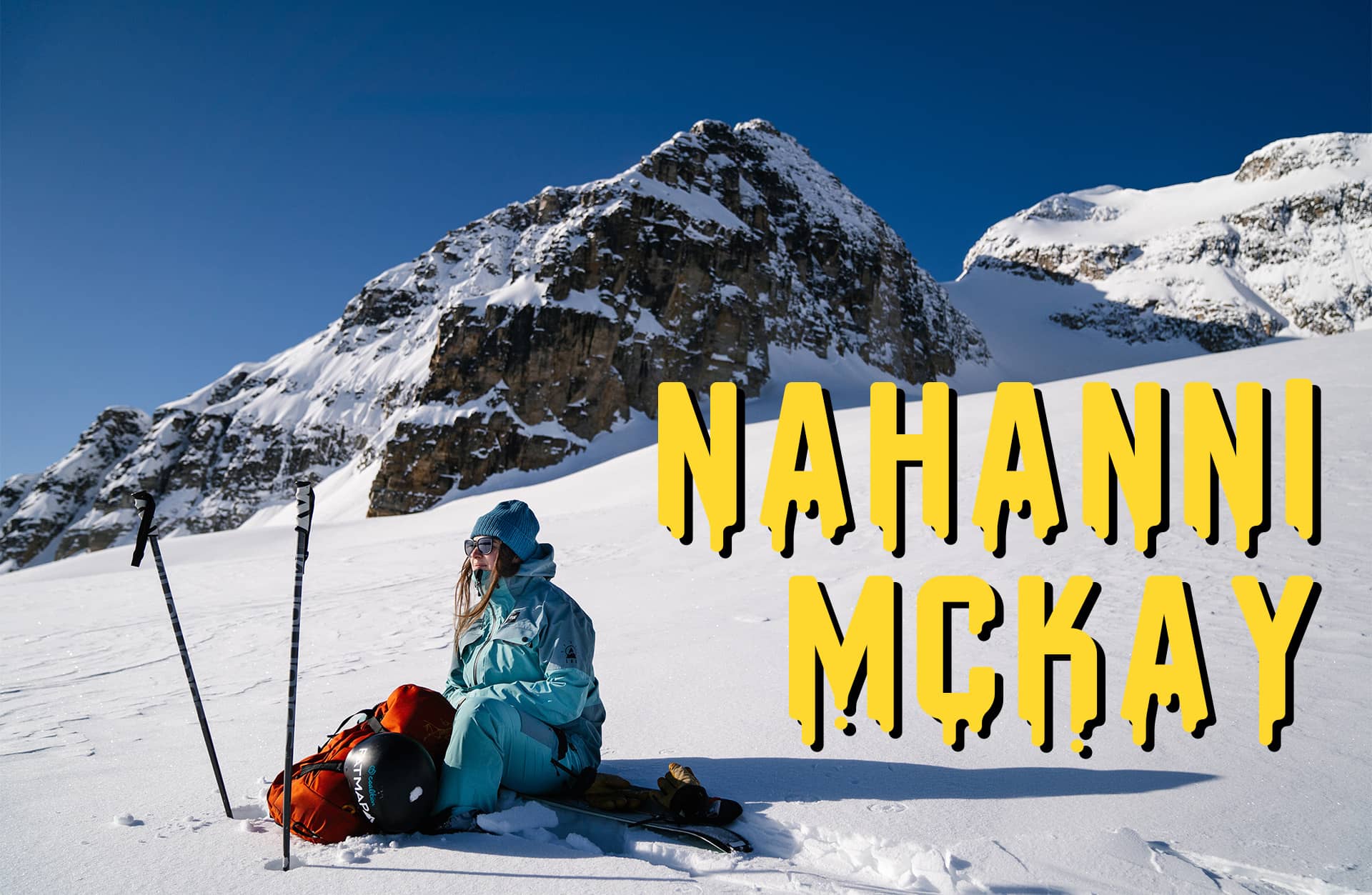CLIMB // 01 MAR 2023
CONQUERING MORE THAN JUST MOUNTAINS
[TW: body dysmorphia, and suicidal ideation. ]
It’s difficult to be what you can’t see. This is a well known hurdle among those lacking representation in the world around them, including plus-sized athlete and activist Bennett Rahn. For Rahn, falling in love with climbing was not just a matter of learning a new sport. It was a long and complicated process of untangling the expectations, both implicit and explicit, placed upon her because of her body. “The more I have [worked on] this process of unfucking my brain from diet culture, and the more I look back at my teenage self, I just want to give her a big hug,” she explained. “I started to [question a lot of] things, these behaviors that I did. Was I really a super bookish kid? Would I have been more interested in [sports] if anybody had treated me like I belonged there instead of treating me like an outsider?”
In order to satiate her mother’s love of hiking and backpacking, Rahn’s childhood summers were spent taking long road trips with her family to a nearby National Park. “We did grow up with some outdoor rec, but when we went hiking, it was with a school backpack and jean shorts. We definitely grew up in a very low budget outdoor community,” said Rahn.
Financial barriers, such as a lack of access to modern gear or being able to afford a weekly ski lift ticket, were one of the many components that built the wall between Rahn and the outdoor sports community. However, when there was a chance for Rahn to enjoy some outdoor fun, she was pushed back out again by the people and narratives around her. “I was told repeatedly, implicitly and explicitly as I was growing up, that because I was fat, I wasn’t athletic,” she explained. “Or that I had to lose weight in order to be athletic. I had a terrible body image and I internalized those messages.”
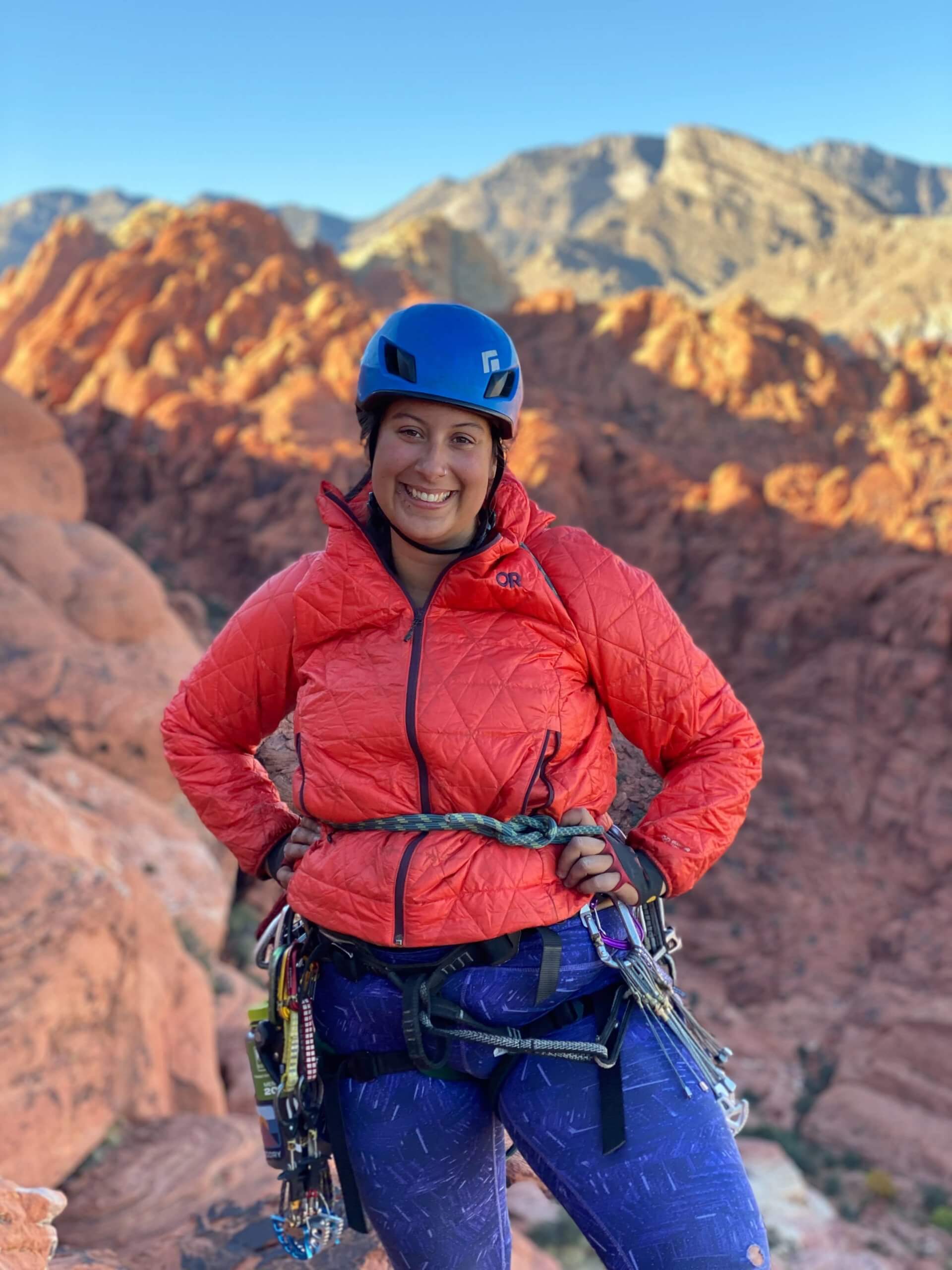
“I have this very formative memory of being in zero hour conditioning with all the football bros and me getting paired with all the girls,” Rahn continued. “I could lift literally twice what they were lifting, and nobody was like, ‘hey, that’s pretty rad. You should keep doing this!’ Instead, they just were like, ‘oh, you’re a fat girl, so you’re not an athlete.’”
When she moved to attend the University of Washington in Seattle, Rahn was immediately immersed in the wilderness crazed community of the Pacific Northwest. Embosomed by a multitude of National Forests, she couldn’t wait to explore the mountains and beyond. “I craved more. I wanted to be involved in those experiences. I learned how to bike and did some backpacking. Again, ad hoc without any of the correct gear and whatnot. I went on a backpacking trip with some of my college friends, and I was so ill prepared. It’s a good thing that I had an effective sleeping bag, otherwise I would have frozen to death,” she laughed.
Yet, packed right next to the college essentials was that negative internal narrative. It spat the same rhetoric, you don’t belong here, and sometimes that voice seemed like it had a point. Shopping for gear that was already expensive, there never seemed to be anything that fit quite right. Rahn struggled with backpacks that cut off circulation and winter coats that didn’t fully cover her stomach. “I was wearing crop top jackets way before it was cool,” she laughed.
Though able to joke about it now, at the time, every piece of gear that didn’t fit right or flat out didn’t exist in Rahn’s size, was more firepower for that internal tirade. Upon graduating college, Rahn knew something had to change, because, as she stated, “my mental health was in the garbage can and I didn’t know what to do.” So, she decided to hike the 500 mile Camino de Santiago through Northern Spain.
“I decided to do that as a ‘#findmyself’ experience,” explained Rahn. “It’s a 800 kilometer through-hike, but not in the way that the Pacific Crest Trail (PCT) is because you don’t have to carry a tent and you can eat fried potatoes and drink red wine. That was the trip that changed my mind. I did ‘#findmyself’. It changed my mind about what I was capable of and what I wanted to be able to do.”
A several hundred mile long hike is not an easy venture to take on, even with fried potatoes. So, it was a surprise to Rahn when she was able to cruise through the hike, as she summed up, “It was definitely hard. I’m not saying that it wasn’t difficult, but I kind of crushed it.”
The hike recontextualized how Rahn viewed herself. Though she’d been consciously working to extricate herself from diet culture since she was sixteen, it was upon her completion of the Camino de Santiago that she was able to claim her narrative for herself. She didn’t have to exist within the expectations society placed upon her. “I definitely did realize like, oh, I’m actually pretty good at this shit,” explained Rahn. “I think the real AHA moment for me while I was on the trail was that I had more fortitude and more resiliency than I expected. I had had a lot of ups and downs with suicidal ideation [during my teens years and throughout college] and I just was like, I can’t believe that I was able to walk 500 miles. I didn’t think it was possible. I thought that I would stop existing before I ever got here.”
When she returned to the States, the fear that had once stopped Rahn from making her own plans to explore the outdoors slowly but surely began to melt away. The trip helped her recognize her own competency in outdoor spaces. Giving her the courage to fully embrace the outdoor lifestyle she coveted.
As is the case for many an outdoorist, hiking and backpacking served as the gateway for Rahn to the wide world of outdoor sports. Soon she was snowshoeing and climbing with coworkers on the weekends. Practicing yoga and mindfulness in her free time. Fully empowered by her new conviction, she began working at a local middle school with an outdoor program.
“I started to feel like I could turn my brain off when I was in those spaces very occasionally and just exist,” explained Rahn. “I remember [before] feeling so awkward and uncomfortable and weird and I had that body dismorphia where you’d catch your reflection in the glass on the street and you’d look at it and be like, oh, fuck. That really visceral feeling.”
“When I got into climbing, it was a combination of [yoga and mindfulness], right? Climbing is very much a body and movement practice, but also the problem solving aspect of it is mentally challenging. It’s not I’m only in my body, but my mind is here and a part of this as well, marrying those two concepts. I really started to feel a lot more comfortable in my movements.”
Rahn has since seen this process repeated when she’s worked with other plus-size climbers. On the wall, knowing how your body is positioned is key to a successful climb, but for people who’ve spent a majority of their lives in a dissociative state, that mind-body interface is practically non-existent. “I’ll say rotate your left knee a little bit into the wall so that you can bring your hips in,” said Rahn, giving an example. “Those directions maybe don’t compute. That is because [plus-sized people] have tried to not embody [their body] and so [new climbers are] not super aware of what their left knee is doing and what their right hip is doing. In climbing, you kind of have to start learning how to think about [your body] and start really existing in all of those body parts. I think that can be really healing and also extraordinarily terrifying when you start. All of that combined really helped me counteract this concept of dissociation that I had been spending a ton of energy on for literally my entire life.”
Day by day, Rahn carved out a space for herself in the outdoor community and what started out as sharing the occasional climbing photo on Instagram transformed into something much more. “A huge part of the work that I do is representation,” explained Rahn. “Just being like, you can do this. I am not exceptional. I am just an average fucking person. If I can go out there and do all of this really cool rad stuff then you can do it too. People have just told you you can’t for a really long time and you didn’t see it [in the world around you] and it’s hard to be what you don’t see.”
Though the body positivity movement has been co-opted by corporations and crammed into hashtags for marketing, the history of fat liberation dates back to a group of activists in the 1960’s. As Rahn explained, “I do think it is really important to bring up the fact that Body Positivity was a movement that was created by Black women to bring to light the systems of oppression against fat people, and specifically fat people that are even fatter than me. What I’m doing, what I’m able to do and what I’m putting out in the world has been built on the shoulders of giants. I’m definitely not the first or the most important of people who are doing rad shit for plus-sized people, for queer people, for anyone [in a marginalized community]. I am learning from them and trying to amplify what they do.”
For Rahn, that means tackling the lack of plus-sized gear in the industry. When the beginner plus-size climber looks to purchase a harness, there is only one truly size inclusive option on the market. The Misty Mountain Cadillac, which goes up to a size 3XL, is designed with a bigger drop that isn’t found on the men’s harnesses plus-sized women typically settle for. Without that bigger drop, climbers end up on the wall with a wicked crotch wedgie, which is not conducive for a great session.
“That’s the really wild thing about being a plus size person, for a really long time we had absolutely no access to any [gear that fit correctly],” explained Rahn. “So, you just got along with what you had. You complained about it, and you knew it was bad, but you kind of didn’t realize how bad it was. Now, in the last five or so years, we’ve been getting access to all of these things, and you’re like, oh, my God, is this what it’s been like for other people the whole time?”
Unfortunately, more often than not, expanding brands plus-sized gear availability is a process of persuasion. Not only do companies need to be convinced that a market for such products exists, they have to be guided away from their tendency to poorly design and poorly market those products, using their inevitable failure as evidence to halt any further projects. As Rahn said, “There are some brands that were like, ‘oh, well, we expanded our sizes on three items, and we only had them in the color black. And we actually didn’t tell anyone that they were available and they didn’t sell.’ It’s like, oh, I wonder why. You have to actually let people know that these things are available in these sizes instead of just letting them figure it out. You’ve never had those sizes before, so why would a fat person be checking anyway?”
Thankfully some companies have better handled these initial trials into plus-sized gear. An example being Gregory Packs. “What Gregory did was they said, ‘it seems like this is a market. It seems like people actually do want this’,” explained Rahn. “So, they did a small, limited run, and it sold out in, like, 30 seconds flat. The thing about that backpack is now people have backpacks that fit them and don’t make their arms go numb, it’s possible to not be crushing your inner organs with your waist strap.”
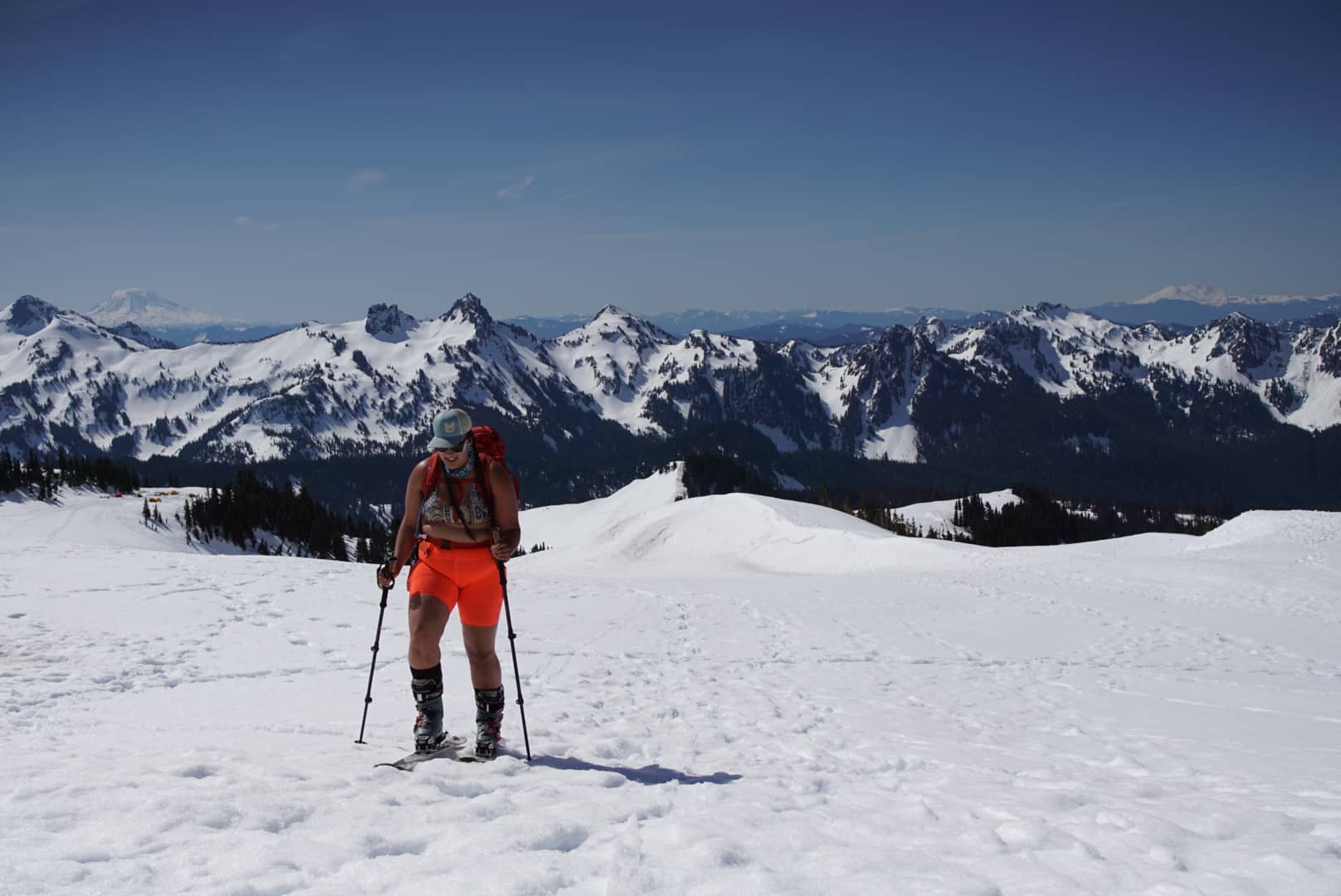
As Rahn has worked with more companies that treat her as a partner and respond well to feedback, such as Outdoor Research, the more grateful she’s become to have access to properly fitting gear. “It’s so freaking exciting, I’m like a kid on Christmas,” smiled Rahn. “You [realize], oh, I have been doing this wrong. Not wrong bad, but wrong, because I didn’t have access to anything for so long.”
Of course even with each success there is still plenty of room for improvement. Many in the plus-size community have pointed out that companies that tout an inclusive sizing label are not actually fully inclusive. By ignoring individuals above the 3X size bracket, companies perpetuate the narrative that such bodies don’t belong in the outdoors. It’s a nasty feedback loop where if an individual is not able to find the gear to exist in a space or see people that look like them in that space, they’re not going to enter it. This leads brands to believe that a market doesn’t exist, so they don’t create the gear or representation for that demographic. “What I tell brands is to create the market,” explained Rahn. “The investment in representation long term is where you build that extended and expanded market of plus size people because they need to be able to see themselves in these clothes and in these activities.”
Approaching the issue of representation in the climbing community through brand marketing is just one pillar of Rahn’s strategy. While there is a great benefit to altering the external societal narrative around the sport, it is equally important for there to be changes happening within the community as well. So in 2022, Rahn completed her single pitch instructor certification. “I think it may seem kind of like a small thing to a lot of people, but I was really freaking proud of myself,” grinned Rahn. “The fact that I was able to do all of that practice and get out there, pass the exam and then find work as a climbing instructor, that is fat. That’s pretty rad.”
The motivation for this accomplishment was in part personal, but was also done in contribution to a larger goal of creating more approachable spaces for plus-sized climbers. As Rahn explained, “I think that learning from somebody who looks like you is so much more powerful than learning from somebody who doesn’t know at all where you come from. People are going to give you tips and beta that are not going to work for you at all. And you’re going to think that it’s your fault and your problem and it’s not. It’s just that your body is shaped really differently and your body weight distribution is different than these people and you have to learn how to manage that for you. [For example,] our legs as plus-sized people are usually pretty strong because we have to carry around more weight than a straight size person on a day to day. We just are better at doing things like squats and deadlifts and whatnot. That is a major benefit to slab climbing. I feel like that’s a superpower.”
While a majority of Rahn’s efforts encourage more folks to enjoy the outdoors, she admits that the added benefit of connecting with other plus-sized, queer, BIPOC, or otherwise marginalized climbers has been a pretty sweet side effect. “More and more affinity spaces have become options where I can plug myself in and feel really welcome,” smiled Rahn. “Every time I’m in those spaces, it’s the concept of like, oh, it’s been like this for everyone [else] all along. [Realizing] oh, wow, I’m not the only one.”
Going into the next year, Rahn has a few intentions in mind. Currently at the top of that list is to get in a good mountaineering season. “The universe conspired against me and my schedule for the last three seasons and has not allowed much of a mountaineering season. So, I’d really like to get more mountaineering under my belt this year. That includes ski mountaineering and alpine rock climbing. I would love to have a spring season in the Cascades and actually climb some mountains.”
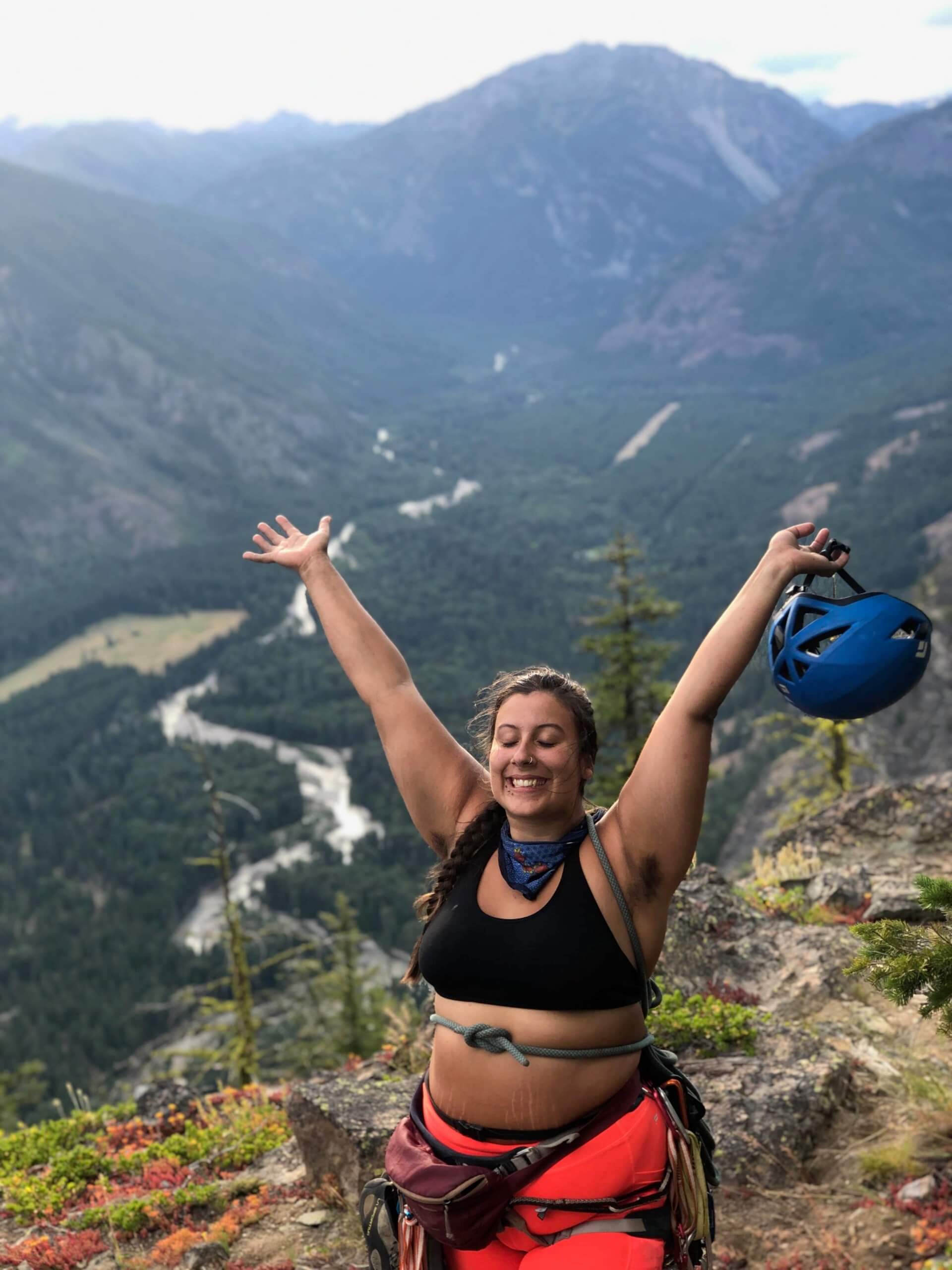
She continued, “On the activism side of things, I would really love to see more. I want to see more people like me. I want to see more brands coming on board. I want people to be buying these things that brands are doing, taking them out and realizing how sick they are and getting inspired by the access to that gear so that it continues to create more market so that there are more people. I just would really love to not walk up to, for example, a ski lift and be like, oh, there’s one other fat person on the mountain today. Clocked, I see you. It would be really cool if these outdoor spaces reflected the diversity in the world at large.”
Too often people trap themselves in boxes based on the limitations imposed by the world around them. Whether it’s the plus-sized, queer, BIPOC, or adaptive community, Rahn wants to encourage anyone who doesn’t fit the mold to look beyond the narrative handed to them. To ask themselves, if no one else was telling you otherwise, what would you want to do? Because, despite what others may have led you to believe, you absolutely can. “You can do all the other shit that the skinny people do too,” exclaimed Rahn. We’re out there doing these sports, but [you just don’t see] that many [people]. What I want to see is more plus size representation across all the sport disciplines and across all sizes. I’d love to see racial and ethnic diversity. I’d love to see more abilities being represented. There are adaptive athletes across the board that do all kinds of really rad things. Let’s make this conversation about diversity more nuanced and more representative of what people are actually capable of.”
